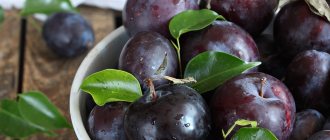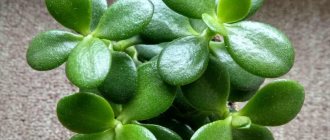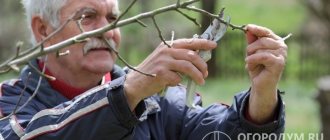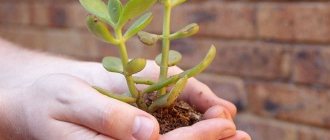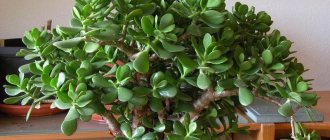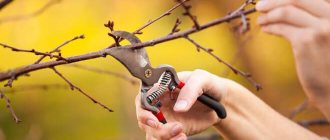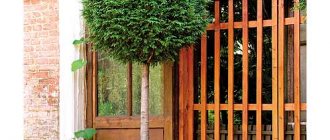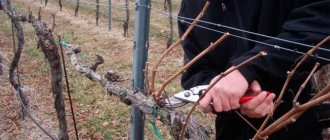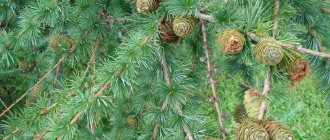Category: Succulents, Care Published 01/16/2019 · Comments: · Reading time: 10 min · Views: 4,637
This popular indoor succulent has many names - Crassula, Crassula, money or coin tree. It is popular among flower growers and is often found in apartments, offices and other premises.
This interest in the flower is due to its pretty appearance, unpretentiousness, as well as the properties attributed to it - attracting financial and family well-being. However, the fact that this perennial does not require special care does not mean that it is not necessary to care for it at all.
Crassula has branching shoots that grow greatly during the growing season, which is why the bush loses its neat decorative appearance. And in order to return the fat woman to its former beauty, the owner should know how to shape the crown of a green pet, making it attractive, but not harming it. Additionally, this is not the only reason why the plant needs to be pruned periodically.
Why do you need to form the crown of a money tree?
At home, Crassula can grow up to 100 cm in height. There are several main reasons why a plant requires regular pruning and pinching of shoots:
- making the crown more decorative;
- increasing bush stability;
- trunk strengthening;
- creating an open space inside the crown, thanks to which air easily circulates between the branches, preventing excess moisture from accumulating;
- preparation for transplantation, during which long branches can interfere with the procedure and break.
An overgrown money tree looks very attractive
Without pruning, Crassula branches can reach quite a long length and bend incorrectly. The weight of overgrown shoots with thick leaves puts too much pressure on the trunk, which is why it cannot maintain a vertical position, and the flower easily turns over along with the pot. Timely implementation of procedures for shortening the branches of the crassula helps maintain the balance of the crown.
How to do it right
Violating the rules of pruning and pinching can cause irreparable harm to the flower. This is why it is important to know how to form a money tree.
You can begin a new procedure for shortening Crassula shoots only after it has recovered from the last pruning. In this case, all curved and strongly branching shoots are pruned so that a straight branch is obtained.
The resulting sections must be disinfected with special means. Often a manganese solution or crushed activated carbon is used for this. Cut parts of the plant can be used for propagation.
Note! The age of the plant should also be taken into account: the lower branches and leaves of a young bush are completely cut off, while an adult plant requires deeper thinning of the crown.
Features of pruning old Crassula
An old succulent that has never been pruned or pinched will grow branches that are too long and often break due to their own weight. The plant becomes overly thickened, untidy, and needs additional attachment to the support. How to rejuvenate Crassula by pruning and improve its appearance? A drastic procedure will be required:
- It is necessary to choose the strongest of the trunks, which will become the central one.
- Weakened shoots located at the bottom of the trunk are removed.
- Long, strong branches are pruned so that 1-2 live buds remain, at a distance of 1-1.5 cm above them. The remaining “stumps” later dry out and fall off on their own. If you make a cut very close to the bud, then it may not wake up, and then you should not wait for fresh shoots and leaves. It is recommended to shorten upright branches that form a tree-like shape. You can make a “test run”, cut off a few branches, observe how the buds grow and later repeat the manipulation more thoroughly.
- Small shoots that thicken the crown and large leaves should be removed. This will improve air ventilation in the crown, access to light and nutrients. The growth points of the remaining branches are pinched, at least one internode. Without this procedure, the development and growth of shoots will accelerate, which will negatively affect the state of the “sleeping” buds and slow down their awakening.
- It is not uncommon for older succulents to have a tilted trunk; in this situation, care should be taken to provide corrective support and trim the branches that are causing the plant to lean to one side.
- It is advisable to blot areas damaged during the pruning process with a soft cloth and disinfect the sections using garden varnish or balm.
- After the event, the soil should be watered abundantly.
For deep pruning of thick shoots and stems, it is most convenient to use pruning shears. Parts that are difficult to access can be removed with a sharp utility knife blade.
If you need to trim several succulents, it is better to treat the blade of the tool used with a disinfectant to prevent the spread of infectious and other diseases.
It is important! Pinching and removing large leaf plates leads to accelerated branching of shoots.
When carrying out the procedure, the following nuances should be taken into account:
- First of all, you need to remove creeping, downward-pointing shoots, as they reduce the stability of the fat plant;
- the plant receives nutrition not only from the soil, but also through photosynthesis, so when cutting branches it is important to leave at least a couple of leaves, otherwise the large branch will begin to dry out;
- any manipulation of home vegetation is a stressful situation, so you should not aggravate the situation of a green pet by replanting; It’s better to postpone this event.
If the procedure is carried out correctly, then after 14–21 days young leaves will appear from the “dormant” buds. And when young shoots grow at the bottom of the succulent, you can leave them temporarily so that the trunk thickens. Later, these branches are pruned so that the crown takes on the shape of a tree.
After processing the money tree in full, it needs to be provided with the most suitable, familiar conditions. This promotes rapid recovery of the succulent. If the flower pot was in partial shade or under the rays of the sun, then it should be placed there.
Sometimes a gardener sets himself the task of completely changing the shape of the Crassula crown. However, it is impossible to take drastic action by removing all branches, since a plant with a weakened root system and insufficient photosynthesis dies. It is better to stretch the event into 2-3 procedures, doing pruning at intervals, during which the succulent will acquire new branches, foliage and get stronger.
When performing repeated pruning, you should take into account which direction the new branches grow. They should be directed outward and not interfere with existing shoots. Those shoots that grow inside the crown are removed.
Schemes of crown formation in Crassula
How to plant a money tree at home
It is recommended to carry out the main pruning in the spring. Subsequent corrective procedures usually occur in the summer, when the shoots actively branch and form many new fleshy leaves.
Flower growers have developed several basic schemes for pruning the crassula - how to form a crown is described below:
- The bonsai technique involves the constant removal of lower shoots and leaves from the central trunk, due to which it becomes stronger and more powerful.
- Creating a fairly tall tree with a thick bare trunk and a lush crown is only possible by pruning the young plant. Formative procedures are carried out regularly throughout the life of the flower, during which all side shoots and leaves are completely cut off. Removing branches from an adult bush will not give the desired result, but can only harm the plant.
- The formation of a neat rounded lush bush of small height is possible by removing new leaves from the trunk and shortening the growing branches.
- A spreading crassula is obtained by pinching the tips of the branches in a timely manner, due to which shoots from the lateral buds begin to grow.
The flower can be given almost any shape
After the pruning procedure, it is necessary to apply fertilizing to help the flower recover.
Where to start forming a tree?
Selection of pot
The diameter of the pot for the fat plant is selected according to the size of the crown: slightly larger than its diameter. As the plant grows, the width of the container needs to be increased. A tree with a voluminous, fleshy crown will become more stable. Ideally, a money tree pot should be wide, heavy and flat. A drainage layer is laid out at the bottom.
Not every pot is suitable for a fat plant. Its root grows close to the soil surface. Therefore, a shallow pot for rooting is suitable. The tap root of a crassula in a deep pot tends downward, and the stem tends upward, while thinning and weakening.
The soil
The soil for Crassula is light, loose, and porous. The money tree does not like fertilized and fertile soil. The substrate for Crassula should include humus, sand, leaf and turf soil.
Home care
When forming the crown and growing Crassula, much attention is paid to location and lighting. Crassula prefers bright light, but direct sunlight will cause the leaves of the flower to turn red. If there is not enough light, the stem will stretch, the branches will bend, and the crown will lose its symmetry. For this reason, it is recommended to rotate the flower periodically. At the same time, do not forget about the fragility of the branches.
Careless handling of the plant will lead to breaking off of the fleshy, heavy branches.
The tree-like fatty plant does not need frequent and abundant watering. Thick and fleshy leaves of the flower are able to accumulate moisture
Crassula is one of those plants that is better to underwater than overwater. It is more demanding when it comes to wiping leaves and general spraying. Clean leaves are saturated with oxygen and become elastic.
When grown in an apartment, Crassulas branch weakly and grow long and thin. Therefore, the crown and trunk of the money tree are formed.
You will find more information about the rules for caring for a fat woman here.
What to do for lush branching of the crown
You can grow a lush, branched money tree only by following the correct agricultural practices:
- periodically removing excess branches and leaves;
- by regular watering;
- fertilizing the plant with special nitrogen fertilizers that promote the formation of new leaves;
- maintaining the necessary air humidity and temperature in the room and providing sufficient illumination to the flower;
- taking timely measures to prevent and combat diseases and harmful insects.
How to transplant a money tree at home
The young plant grows very actively, so it is replanted annually in the spring, choosing a larger pot. Crassula requires loose, breathable soil, under which a drainage layer must be placed. The bottom of a capacious pot should have special holes to drain excess moisture.
Important! When planting a fat plant, organic matter and minerals are immediately added to the soil to strengthen the root system and more active growth of greenery.
Due to increased soil moisture, the money tree stops growing, its foliage becomes dull and takes on a sickly appearance, and the roots and trunk may rot.
A weakened plant is susceptible to pest attacks. Therefore, watering the plant should be regular, but without stagnating moisture in the soil. It is recommended to carry out it twice a week on hot summer days and no more than once a week in winter.
If the indoor air is too dry, Crassula needs a refreshing spray. In addition to increasing the humidity level, this procedure will help rid the leaves of accumulated dust.
Excess shoots should be trimmed at the very base
The money tree loves good lighting, but it should be shaded from direct sunlight. If this is not done, black burn spots may appear on the fleshy leaf blades. You should also turn the plant towards the light so that all parts of the crown receive their share of lighting.
The most suitable temperature for Crassula is considered to be +16..+20 °C; when these indicators increase, the plant may begin to shed its leaves.
Note! The composition of fertilizers for Crassula must include phosphorus, potassium and nitrogen.
How to properly plant Crassula in a pot
Already rooted and growing cuttings are planted in pots. The pots should not be small, but only those that can accommodate the entire root system. Leave a gap of 1 cm from the roots to the walls of the pot, and then fill the voids with earth. Plant a fat plant in a pot like this:
- A drainage layer is placed at the bottom of the pot. It shouldn't be small. Typically the drainage layer is 3 cm or more. The following drainage materials are used: broken brick, expanded clay and small river pebbles;
- Soil about 1 cm thick is poured onto the expanded clay layer so that the roots do not touch the drainage. Next, the cutting with roots is carefully placed in the center of the pot, straightening the roots. The root system is covered with new soil, the soil is lightly pressed down;
- Then the planted tree cuttings are lightly watered;
- The pot is placed in partial shade. He will be in low light until the tree grows. After this, the lighting can be gradually increased, and then even the tree can be accustomed to direct sunlight.
How to pinch Crassula
Not every gardener knows how to form a crassula into a beautiful tree. In addition to timely pruning, the plant requires pinching, in which the upper parts of the branches are removed. This procedure prevents the shoots from growing in length. In addition, it allows you to obtain the desired shape of the bush, making it spreading, round or creeping.
Money Tree - how to plant it correctly to make money
The procedure does not require special tools - the tops of the shoots can be shortened manually. The most common method is to shorten the lower and upper branches with fingers, so you can decorate the tree in bonsai style.
Important! This procedure not only adds decorative value to the flower, but also relieves it from thickening the crown, that is, it also has sanitary purposes.
The tops of the shoots are pinched with clean hands.
When to do the first pinch
For the first time, the procedure is carried out after the appearance of the 4th pair of leaves. You can leave more paired leaf plates, but it is worth considering that then the overgrown crown will turn out to be too heavy.
The plant is pinched until it takes on a certain appearance. You should not spare small leaves that require pinching, as they will subsequently interfere with the plant itself.
How and when to do preventive pinching
The young plant does not yet have a large number of large, heavy branches. Therefore, in the first years of life, Crassulas often try to form a strong tree with a powerful and stable trunk that can hold the crown in the future.
The top of the shoot is removed with clean fingers or disinfected tweezers, grabbing the outermost pair of leaves at the very base. The movement should be precise, slightly twisting, not jerky. If the leaves are not completely pinched off, they will continue to grow, although they will be deformed.
Topping
Pinching is carried out together with pruning. This method is known to experts as pinching, which means removing the apical parts of young shoots. It is used to prevent upward growth and to allow the development of the lateral parts. The principle of the method is to remove the top of the main shoot when it has grown noticeably. Poorly developing shoots or those that grow inward are pinched.
When to do the first pinch
This is the question that is asked more often than others. The first pinching is done when 3 and 4 pairs of leaves appear on the branch. If you pinch a plant with less, then, as they grow, they will begin to interfere with each other. If you leave more pairs, the branches will lengthen and it will be difficult for them to hold dense and heavy leaves.
How to pinch Crassula correctly
Pinching (pinching) of the crassula is carried out until it begins to take on the desired shape. The shoot is pinched off with rotational movements to capture the entire shoot and not leave particles on the branch. As a result of pinching between the 3rd and 4th pairs, branches are formed that do not grow in length, but form a tree with neat, identical branches. After the procedure, the pot with Crassula is regularly rotated to achieve uniform illumination on all sides.
Important! Crassula is watered with water at room temperature.
Pruning Crassula
Before you undertake this procedure, you should study in detail how to properly prune a money tree. A plant that is accustomed to the annual shortening of shoots will be easier to recover from them in adulthood. This is the only way to get a healthy flower with a beautiful crown of the desired shape.
Note! All procedures for shortening plant shoots are recommended to be carried out in the morning.
At a young tree
Pruning can only be done with a sharply sharpened tool, otherwise you can harm the tree. At home, they usually use the following step-by-step technique for pruning young Crassula:
- The lower small shoots, as well as single branches, are completely cut off.
- The lateral shoots are pinched.
- The outermost pair of leaves is removed from mature woody branches.
- Cut off the upper branches that stretch in height.
- All sections are moistened with an aqueous solution of potassium permanganate.
A money tree that is not pruned in the first years of its life grows branchy and actively bushes.
Note! The branches are shortened by no more than 1/3, and the cut is made at an angle of 45°.
After proper pruning, the plant develops a powerful central trunk.
By the old tree
A money tree older than 5 years especially needs to shorten its branches. Otherwise, its central trunk may break, unable to withstand the weight of powerful shoots and thick leaves. An overgrown adult Crassula is pruned as follows:
- The widest and strongest central trunk is determined.
- Trim all shoots from the bottom of the plant.
- All thick ones are cut off.
- Remove large leaves, as well as small shoots in the upper part of the bush.
- The sections are disinfected and lubricated with garden varnish.
Cut parts of the Crassula are used for rooting as independent plants.
For what purpose is succulent pruning done?
In its natural environment, Crassula can grow up to one and a half meters in height, however, domestic specimens are much more compact and modest. Its shoots are pruned for a number of reasons:
- To enhance decorative properties and give a beautiful shape.
- To improve the stability of the flower, overgrown, decaying bushes often die. Their shallow root system cannot support the weighty crown of the succulent and literally falls out of the pot.
- To form a strong main trunk - in this case, the fat plant needs methodical deep pruning.
- To make caring for a green pet easier, replanting, watering the plant, and removing damaged branches is much more difficult if it consists of overgrown, twisted, or too long shoots. Hygienic pruning can solve this problem.
Experienced gardeners advise not to delay pruning an adult money tree and to do it as early as possible. The flower will tolerate the procedure much better and recover faster if a small number of shoots are removed.
The main pruning is carried out in early spring, before the tree enters the active growing season. Corrective action can be carried out in the summer, shortening asymmetrical, very elongated shoots. It is recommended to pinch the growth points located on the side branches.
In order for the crown of the succulent to form correctly, pruning is carried out more than once, focusing on restoring the bush after cutting off the branches and foliage.
It is very easy to process small sprouts; just break off the lower leaves and branches, which will strengthen the central trunk.
Pruning an adult Crassula is deeper; after the event, many branches remain, which, if desired, can be used for cuttings of a succulent. Curved cuttings are trimmed so that only straight sections remain. Their lower part is freed from leaves and sent for rooting - in a container with water or soil substrate.
Forming a succulent crown like a bonsai
The bonsai form is characterized by a powerful central trunk with branches hanging down. Such a plant can be obtained by regularly pruning and pinching shoots at different levels.
Formative procedures begin to be carried out on the young plant, while simultaneously strengthening the central trunk. To do this, in spring and summer, you should cut off unnecessary branches in the lower part of the trunk and shorten the upper ones. The flower is regularly watered and fed, then the trunk becomes stronger and wider.
For the first 2-3 years, the tree leaves the 2 thickest branches, allowing them to grow, after which they are shortened to the desired length. Next, the branches growing vertically are pruned, and the tips of the lateral ones are cut off. In addition, all the upper shoots are pinched off so that the branches continue to grow only in the downward direction.
As the shoots grow, all excess shoots should be trimmed in a timely manner.
Important! A real bonsai from a crassula can only be obtained if it is replanted annually in compliance with all the rules.
Bonsai
Buy a healthy crassula with a thick stem and compact branches. Crassula ovata and Crassula arborescens species that make excellent bonsai include varieties such as 'California Red Tip', 'Hobbit', 'Bronze Beauty' and 'Tricolor'.
Container preparation
Choose a container that will suit the size of your future bonsai well. Deep containers are good for plants with thick stems and leaves.
Cut pieces of chicken wire slightly larger than the drainage holes to prevent soil from leaching out of the container . Cut a piece of wire about 7 centimeters long and make loops at each end.
Make the distance between the loops equal to the size of the drainage hole. Place the loops on the sides of the drainage hole and thread the ends of the wire through it. Leave loops on both sides of the drainage hole. Place the mesh over the hole and secure it by bending the ends of the wire. Attach the support wire in the same way to secure the tree itself.
Photo of Crassula (Crassula, Money Tree) bonsai.
Preparing and planting the plant
Prepare bonsai soil mixture or buy it at the store. The soil should be well permeable.
Remove the Crassula from the pot. Remove the soil from the roots . Gently untangle them and straighten them using a hook.
Trim the roots to fit your chosen container. Remove any dead roots and large roots growing downward.
Remove weak and bare branches with sharp scissors. Remove each opposing branch with a concave pruner to create interspersed branches.
Distribute a small amount of soil in the container. Place the tree in the container, carefully spreading out the roots. Secure the tree with support wire. Fill the container with soil, leaving 1/2 inch between the soil and the edge of the container.
Spread granular fertilizer following the instructions on the package. Place moss or small stones on top of the soil.
Water thoroughly until water appears in the pan. Place in a sunny location with some afternoon shade.
Creating a tree
How to make a bonsai from a money tree (crassula)? How to grow it correctly? Form a compact tree according to the shape you want. First, carefully examine the tree and only then remove branches that do not correspond to the shape you have chosen. When removing small branches, cut closely . Do not leave unsightly cuts. Do not make concave cuts. Leaving holes where rot can settle.
Identify the stems you want to develop into bonsai branches by pinching off leaves and leaf buds along the stem. Allow the miniature leaves to grow at the ends and remove the remaining leaves. Repeated pruning helps stimulate the development of more closely spaced buds and the Crassula becomes more tree-like each time.
Allow the cuts to dry and heal . The cuts do not need to be covered. This can cause rot to develop.
Remove cut leaves and branches carefully from the inside of the Crassula crown using long pliers or tweezers. Using tweezers instead of hands gives greater visibility and better control when working in small spaces.
Trim Crassula weekly. With each successful pruning, the leaves become smaller and the tree takes on an ancient appearance. There are strict rules for forming bonsai from ordinary trees, but in the case of succulents there is no need for them.
Bonsai trees should not be made to lack nutrients in order to keep them small. They need to be regularly watered and fertilized, and their branches and roots trimmed. This is what keeps them in shape. By pruning during replanting, the formation of fine roots is stimulated.
The roots grow more densely after pruning and can receive all the necessary substances for life in a small container. Only thick roots are trimmed. Thus, a fibrous root system is formed.
Trim the roots during transplantation. Crassula roots can be very sensitive to pruning, so when the plant is young, repot only every two years and every three to five years as it gets older. Do not remove more than one-third of the root mass and try to disturb the new roots as little as possible.
Wire wrapping
Train long branches into the shapes and directions you want using soft copper wire . The wrapping should not be tight. Gently bend the wire over the course of a week to get the shape you want.
The fat woman responds quickly to wrapping and can form the desired shape in three weeks.
If the wire has left marks on the branches, they will disappear as soon as water fills their tissues after removing the wire.
Watering
Most bonsai should be watered for long periods of time to keep the soil moist. When watering the Crassula, make sure the soil is dry .
If the soil is too wet, the tree will not develop a large enough root system to support its own weight, as water will accumulate in the succulent's leaves. Watering can be delayed until the leaves have wrinkled slightly.
Check out other representatives of herbaceous succulents:
- hoya;
- aeonium;
- young (stone rose);
- aichrizon;
- Jatropha;
- apthenia;
- delosperma;
- ceropegia;
- bryophyllum.
Problems
The roots of a Crassula bonsai can rot if there is no good drainage and the soil does not drain water well. This problem can lead to the death of the plant. Too much water forces air out of the soil and kills roots. If pathogenic bacteria are present in the soil, they can penetrate dead roots and harm the tree. When replanting, if you find dark, soft roots, cut them off and replace the soil.
Trees with thick trunks do not grow at night. You need to be sure that your plant is well watered, fed and in the correct size pot. Big trees don't grow in small pots. It is a myth. Most bonsai growers grow their trees in large pots or outdoor greenhouses before planting them in a container.
Read more about possible diseases and pests of Crassula.
The Crassula is a long-liver . If you get this plant young, it will be with you for a very long time. He will change houses with you, see your children, and share household chores with you.
As a result, at a very mature age, looking around the room and seeing a crassula in the corner, you will come to the conclusion that this plant is the most valuable thing you have.
Further care after pruning
A succulent that has been pruned must receive proper care in order to recover well and quickly. The most important thing is to maintain the level of humidity and air temperature in the room where the flower is located.
Crassula responds gratefully to compliance with the conditions of detention
To make the pruning procedure painless for the money tree, you should adhere to the following rules:
- treat the cuts daily with disinfecting compounds so that they can heal well;
- provide the plant with sufficient lighting;
- set the room temperature within +15..+18 °C, avoiding even short-term hypothermia below +6 °C;
- regularly fertilize the soil in the pot with complex compounds for succulents;
- spray the bush with a spray bottle and wipe dust from the leaves;
- water the flower every 2-3 days, avoiding stagnation of moisture.
Note! Water for irrigation should sit for at least 6 hours and be at room temperature.
You can get a magnificent fluffy specimen of Crassula at home only through proper regular pruning of the succulent. An overgrown, well-groomed money tree will look very attractive and will be a wonderful addition to the design of the room.
Aftercare
New buds are pinched at the stage of their appearance in order to immediately form a correct crown. After any pruning, aftercare is important.
The wicker money tree requires little water. Watering once a week is sufficient. Any plant grower should know that the volume of moisture added depends not only on the temperature in the room, but also on the size of the container and the composition of the soil.
Water the roots of the tree when the soil becomes dry to the touch. Use a watering can or long-necked jug to reach the roots of the plant, as water on the stem or leaves can cause rot. In winter, the amount of watering is significantly reduced. The colder the room, the less moisture the flower requires.
The money tree loves well-drained soil. Water should not be allowed to stagnate in the ground, as the roots and stem will begin to rot. As a result of the putrefactive process, the plant ceases to receive the required amount of oxygen and nutrients, the foliage changes color and begins to fall off. Getting rid of rot takes a lot of time and effort, sometimes the money tree dies. Therefore, the grower will need to take care of the quality of the soil and avoid waterlogging. The soil should contain a mixture of soil and small gravel pebbles, which are placed in a pot with one or more drainage holes. They allow excess water to freely exit to the pan. Some bonsai grow well in a mixture of peat, vermiculite and perlite in a 2X1X1 ratio.
The tree needs to be replanted every 2–3 years. If the grower notices that the root system has filled the pot, it’s time to change the container. The best time for this is mid-summer. The flower is removed from the pot and placed in new soil and a new container. You can cut off a few roots, remove damaged, weak, old ones. To do this, use a simple pruner, but only one that must be treated with alcohol.
Money trees are very hardy and not susceptible to disease, but if whiteflies or aphids invade, they can be controlled with a solution of soap and warm water. The treatment is carried out in the bath or outside if it is warm there. An increase in moisture is always detrimental to any insect. The procedure is repeated as necessary. After this, you will definitely need to wait until the water in the pot drains before putting the flower back in its usual place.
For a money tree, you should choose a place with a moderate amount of sunlight. This plant can survive in different conditions, but for its normal development it is worth making sure that there is the same amount of shade and sun during the day. East and west windows are the best place to grow a flower
When the first signs of light deficiency occur, artificial lighting can be installed.
It is important to avoid exposure to direct sunlight for long periods of time as this can cause burns. Bright but indirect light is ideal for the money tree, so it is better to place the flower behind a curtain, preventing the foliage from touching the glass.
Being a tropical plant, the money tree can withstand large temperature changes
Its growth slows down slightly as the air temperature increases, but this does not harm the tree. Likewise, low temperatures may cause a little damage, but nothing serious will happen until they drop to -2°C.
From time to time, fertilizing is required. To enrich the soil with additional nutrients, a diluted complex liquid fertilizer can be applied for several months from spring to late autumn.
Brown dry leaves are a symptom of a lack of necessary moisture in the air or a sign of poor lighting. These trees can go into shock when moved to different environments, so they need to be given time to adjust to their new environment. The plant should be placed in a place where there is no draft, away from the radiator and other heaters, ventilation holes and air conditioning.
Sometimes stress after pruning manifests itself as leaf fall. During this period, it is worth placing the plant in a brightly lit place and leaving it there until the tree recovers. Increasing the humidity around it can also help. You can use a spray bottle or automatic humidifiers, and place a container of water and pebbles nearby. The main thing is to prevent water from getting on the surface of the foliage.
How to correctly form a money tree, see the following video.
Use quality pruning tools
To trim indoor plants, use garden pruners, a knife or scissors. All tools must be clean and well sharpened. This will allow you to make even cuts, not harm the plants and avoid future rotting.
The fat woman is not whimsical and copes with the restoration itself, so there is no need to cauterize the cuts. But if you plan to prune several plants, be sure to disinfect the tools before moving on to the next one. You will need a couple of minutes to wipe the blade with alcohol or other antiseptics, and this is a guarantee of safety for plants.
Follow these rules and be a little patient. You won't be able to create the perfect shape in one go. But with proper care, the money tree will delight you with a luxurious crown and prosperity in the family.
